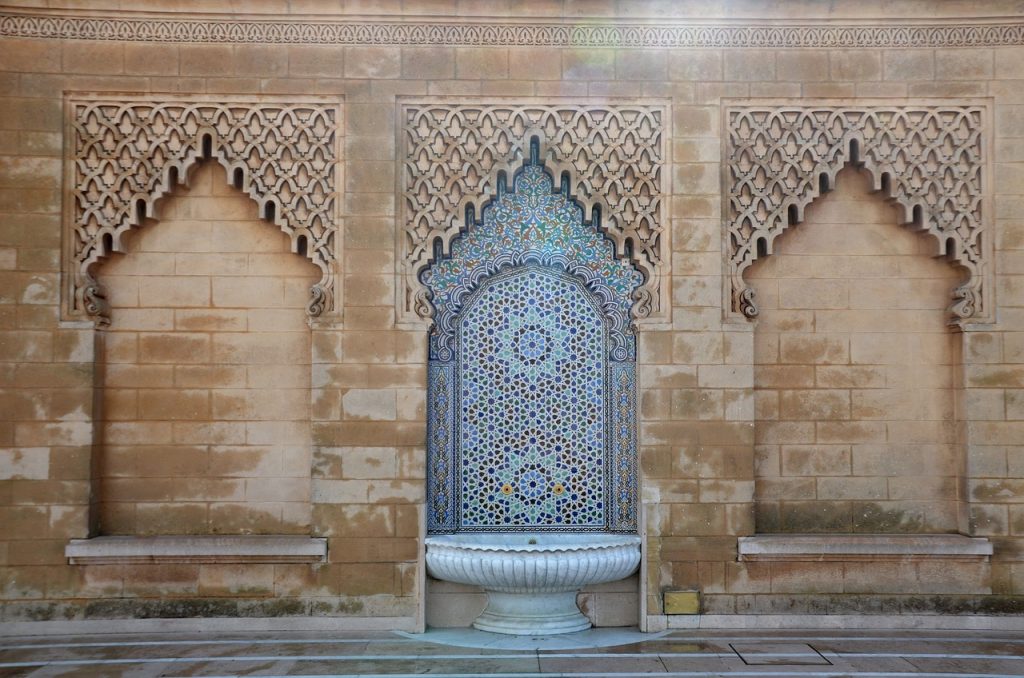Islamic Wall Art

Islamic wall art brings a rich tapestry of cultural heritage and spiritual depth to your space. Using materials like metal, canvas, and glass, these artworks often feature profound spiritual quotes and intricate calligraphy designs such as the Shahada and Ayat al-Kursi.
Techniques like 3D metal cutting and Arabic calligraphy emphasize both aesthetic beauty and spiritual significance. High-quality materials like stainless steel and plexiglass guarantee durability and timeless charm.
When placed in living rooms or entryways, these pieces enhance the room’s ambiance. Explore the nuances of choosing the perfect piece to complement your style and décor.
Key Points
- Islamic wall art often features calligraphy of significant texts like Shahada, 99 Names of Allah, and Ayat al-Kursi.
- Materials used include stainless steel, gold, silver, copper, and plexiglass for durability and aesthetic appeal.
- Designs incorporate techniques like 3D metal cutting and intricate Arabic calligraphy.
- Pieces can be enhanced with LED lights to combine visual appeal with profound meaning.
- Artworks are positioned in living rooms or entryways to maximize spiritual and aesthetic impact.
Types of Islamic Wall Art
Islamic wall art frequently encompasses a variety of forms, including metal, canvas, and glass pieces, each uniquely contributing to the spiritual and aesthetic ambiance of a space.
You’ll find that these artworks often bear symbolic interpretations and inspirational quotes, which serve to elevate the viewer’s spiritual reflection. Historically significant pieces like Ayatul Kursi and Bismillah are transformed into contemporary styles, blending tradition with modernity.
The incorporation of LED lights in some designs adds a modern touch, enhancing their visual appeal while maintaining their profound meaning. These diverse forms of Islamic wall art don’t just decorate; they infuse spaces with rich cultural heritage and timeless spiritual messages, making them integral to both historical and contemporary settings.
Popular Calligraphy Designs
Many popular calligraphy designs in wall art prominently feature verses from the Quran, meticulously crafted with Arabic script to evoke both spiritual reverence and aesthetic admiration. These designs draw deeply from creative inspirations and hold historical significance.
They often include:
- Shahada: The Islamic declaration of faith, symbolizing a core belief.
- 99 Names of Allah: Celebrating the divine attributes, each name is artistically rendered.
- Ayat al-Kursi: A verse from the Quran, known for its protective qualities.
- Surah Al-Fatiha: The opening chapter of the Quran, often displayed for its profound meaning.
You’ll find that these designs not only enhance a space’s beauty but also embed a rich tapestry of cultural and religious symbolism.
Materials and Techniques
A diverse array of materials and techniques are employed in crafting Islamic wall art, guaranteeing each piece not only embodies spiritual significance but also showcases exceptional craftsmanship.
You’ll find materials like stainless steel, gold, silver, copper, and plexiglass being utilized. Techniques such as 3D metal cutting and Arabic calligraphy create intricate designs that capture the eye. These high-quality materials guarantee the artwork’s durability and longevity.
Additionally, various finishes like aging and stainless steel enhance the visual appeal. Different color options, such as black, gold, and white, offer a wide range of choices, allowing for personalization. The combination of metal craftsmanship and artistic detail ensures each piece is both a visual and spiritual treasure.
Incorporating Wall Art at Home
By leveraging the exceptional craftsmanship and diverse materials discussed, you can seamlessly incorporate Islamic wall art into your home, enhancing both its spiritual ambiance and aesthetic appeal.
Focus on these key elements:
- Color Selection: Choose colors that complement your existing decor. Neutral tones can create a serene environment, while vibrant hues can make a bold statement.
- Placement: Position pieces where they can be appreciated, such as living rooms or entryways, to maximize their impact.
- Material Choice: Opt for materials like metal or plexyglass that align with your home’s style and durability needs.
- Maintenance Tips: Regularly dust and clean the art with appropriate cleaners to maintain its luster and longevity.
Choosing the Right Piece
Selecting the right piece of Islamic wall art involves an important consideration of space, personal aesthetic, and the symbolic meaning you wish to convey. Start with size considerations to make sure the artwork fits perfectly within your designated space.
Your artistic preferences should guide you in selecting a design that resonates with your style and complements the room’s existing decor. Pay attention to color schemes; harmonious hues can enhance the overall ambiance.
Placement tips are vital—position your piece where it can be appreciated without overwhelming the room. Opt for high-quality materials like stainless steel or metal for durability.
Frequently Asked Questions
Can You Have Islamic Wall Art in Bedroom?
You can definitely enhance your bedroom aesthetics and create a spiritual ambiance by incorporating Islamic wall art. This choice reflects personal preferences and beliefs, contributing to a peaceful, inspiring atmosphere in your private space.
What Are the 4 Different Types of Islamic Art?
You’re asking about the four types of Islamic art. They include Calligraphic Designs, Geometric Patterns, floral motifs, and arabesque designs. Each form holds deep cultural significance, reflecting various aspects of Islamic spirituality and aesthetics.
What Are the Rules for Islamic Art?
You must follow rules against depicting human or animal figures, focusing instead on geometric patterns and calligraphic designs. Symmetry, repetition, and Quranic verses are essential, aiming to evoke spiritual contemplation rather than realistic representation.
What Is Islamic Art Called?
You’ll find Islamic art is often called ‘Islamic calligraphy’ due to its elegant calligraphy styles, or ‘Islamic geometric patterns’ because of its intricate geometric patterns. These terms highlight the art’s distinctive aesthetic and cultural significance.
Conclusion
Incorporating Islamic wall art into your home isn’t just about decoration; it’s a profound way to connect with a rich cultural heritage. By understanding the types, calligraphy designs, and materials, you’re equipped to make informed choices.
Whether you’re looking for a striking piece of calligraphy or a geometric pattern, selecting the right artwork can transform your space, reflecting both personal taste and historical significance.
Remember, the right piece will resonate deeply, creating a harmonious and meaningful environment.